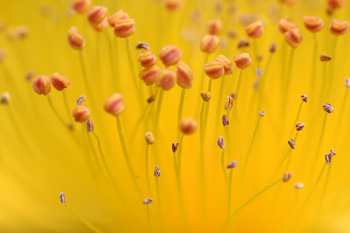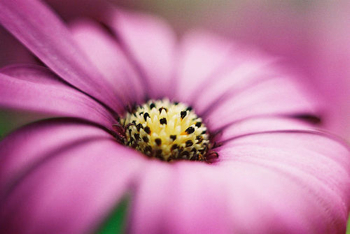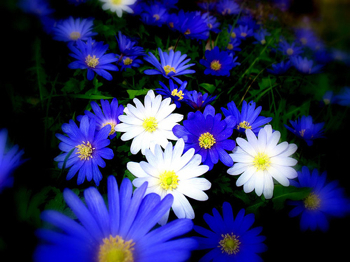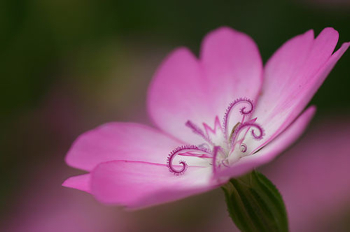
Preparation is key
Getting your gear together and in working order, choosing the right lens, having a tripod set up and then preparing to take the image. Pause and examine your subject before pressing the shutter. Some questions to ask:
- how to crop it – get in close or take a wider angle shot?
- what is the focal point/point of interest? Insect, stem, colour, texture, shape etc?
- what angle will you shoot from to get the best perspective?
- how much depth of field do you want?
- how is the subject lit?
- which flower is the best specimen for your photo?
- what distractions are there in the background and foreground?
- which is the best format to shoot in? (horizontal or vertical)
Highlighting subjects
One of the questions above is worth a little extra consideration – ‘what distractions are there in the background and foreground?’
Gardens are filled with all kinds of potential distractions. They might be the tool shed, a fence, other flowers, the clothes line etc. A decision needs to be made whether you want to include these elements or remove them from your shot. Either option is legitimate but in most cases you’ll probably want to remove them unless they in some way enhance your shot. There are a number of options open to you if you want to remove distractive elements:
- move them – some distractions can be moved pretty easily so that they’re not in your frame
- move yourself – find a new angle to shoot from that has a less distracting background
- crop them out - go for a tighter framing of the flower either by using a zoom or moving physically closer to it
- use aperture to narrow depth of field – as we highlighted in our introduction to aperture, if you choose a wider aperture (small numbers) you’ll decrease the depth of field. As you do this you make elements in the foreground and background more and more out of focus.
- move your subject - I’m not a big fan of intervening in a scene too much but some photographers will move the flower to a new location for the shot. This might include getting someone to hold the stem on a different angle or could even mean picking the flower and taking it elsewhere. If you’re going to do this make sure you are aware of the environmental impact of your photography.
Don’t ignore the dead, marked or dying flower
Sometimes carcasses of flowers can present you with wonderful subject matter. While the perfect flower is the one you’ll probably be drawn to first sometimes the more interesting shot is the ‘ugly duckling’ beside it.
Identify a focal point
As in all types of photography you need to think about where you want your viewers eye to be drawn. Consider setting it off centre using the rule of thirds – but do find something in your frame that will grab your viewer’s eye and carefully think about how to position it.
Go abstract
Sometimes going in extra close and focussing in on a part of the flower can create wonderful and unusual images that take on an abstract quality. Look for contrasting colors, patterns and textures.
Sharp focus is important in all forms of photography but in flower Macro photography it is crucial and even a tiny adjustment can have massive implications for your shot as the depth of field is so small. In macro photography your depth of field is a game of millimetres so attention to detail in focussing is something to be worked upon.
Identify the point of interest that you want to be in focus and then work hard to ensure that it’s as sharp as possible. This can be a real challenge, especially outdoors on breezy days where you’ll probably end up taking a lot of images and relying on luck to some degree! You can improve your ‘luck’ a little by photographing in a more controlled environment (taking flowers inside for studio shots, shielding them from wind or just choosing to do your photography on a still day).
Lighting
Ideally your subject will be wonderfully lit without you needing to offer any assistance, however the world of outdoor macro photography is often far from ideal and there might be a need to intervene with either artificial light or some kind of reflector.
Using a flash is something to experiment with. Generally you’ll find that direct flash on automatic mode might wash photos out a little so consider using a flash diffuser and/or bouncing your flash off another object. I find that the more subtle and indirect the flash is the more natural your shots will look.
Reflectors can also be handy in shooting flowers as they give a nice, natural, diffused light into areas of your subject that might not be getting natural sunlight. Experiment with different colored reflectors as they can really impact the colors in your shot.
Lenses
Point and Shoot Cameras – if you’re shooting with a point and shoot camera with no interchangeable lenses you’ll obviously have less options here. You will probably have the ability to switch your camera into macro mode (which will allow you to focus a little closer and will tell the camera to use a large aperture giving you a shallow depth of field). Some point and shoot cameras do have the option of a macro lens attachment also to allow closer focussing (see your owners manual).
DSLRs – if you have a camera that allows interchangeable lenses (DSLR and some prosumer cameras) you might like to consider buying a purpose built macro lens. Most of the major camera manufacturers offer a range of them. For example offers a number including ones at focal lengths of 50mm, 60mm, 100mm (the one I own), 180mm etc. Each will have it’s own specifications and strengths (do some careful research before buying). Obviously a shorter focal length means you need to get physically closer to your subject to really hone in on your subject while longer ones allow you to shoot from further back (helpful when photographing insects).




